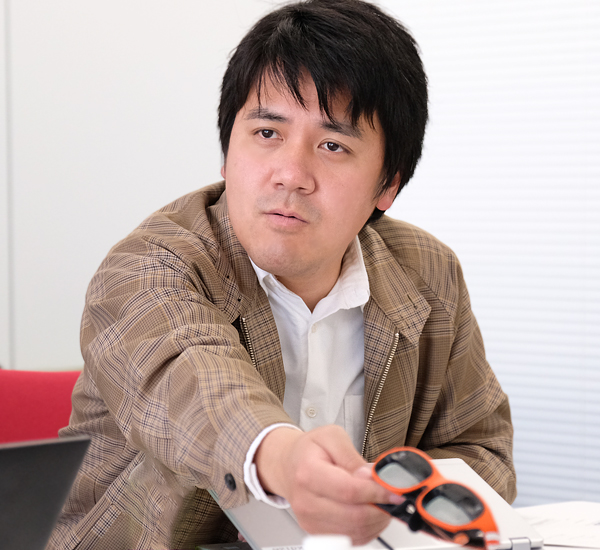
Creating a New Future with AR Solutions -- The Challenge of KDDI Digital Design
Since its inception in 2018, KDDI Digital Design (KDI), a joint venture between KDDI and NRI, has been supporting clients who are promoting digitalization. At KDI—at the forefront of digitalization—ambitious initiatives have begun, centered on young volunteers. In this article, we will introduce an “underground” project, where KDI Vice President Hiroshi Tatematsu (at the time of the interview) and five members (Akira Shimae, Shin Namiki, Takatoshi Hashimoto, Ryota Kontani, and Shinsuke Usuda) have taken on the challenge of developing augmented reality (AR) solutions.
Volunteers gather to discover the possibilities of AR glasses

Members with different work backgrounds and home companies started the project together because Mr. Namiki suggested that something could be done with the “nReal Light” AR glasses. Unlike the AR devices we’ve seen so far, the nReal Light glasses are lightweight, so they can be used like sunglasses, and they can closely interweave the real world and the digital world with a wide field of view. Five volunteers who expanded the conceptual range of various ways the device can be used gathered together and began studies toward commercialization. With the support of Tatematsu, who had caught wind of these “underground” activities, the members promoted workshops and proof-of-concepts involving clients on a self-led basis in addition to their regular work.

In the past, the proliferation of Walkmans (portable media players) and mobile phones made it possible to take communication like telephone and email, music, and video with you when you leave the house. These functions were once integrated into smartphones, but these days, dedicated devices are reappearing with functions not found in smartphones, such as vital data management and high-quality audio. AR glasses are one of these devices, sensing what is in front of you and allowing you to see it while superimposing text, video, computer graphics, and images etc. in a hands-free manner. Existing “xR” devices are heavy and bulky, they are difficult to wear while walking, and they are expensive, but the nReal Light is lightweight, can be worn without discomfort, and is expected to cost something in the range of a few hundred dollars. In addition, if fifth-generation wireless communication standards become widespread, it will be able to handle heavy data loads without stress.
Tackle use cases with operational efficiency and customer experience value
Even if a device has all the requirements for widespread adoption, like a comfortable fit and a reasonable price, if it can’t solve some problem that customers have, it can’t be commercialized. From the starting point of issues customers have, members have considered ways to utilize the features of the device, studying use cases in two directions: improving work efficiency and improving customer experience value.

One of these is utilization at retail sites, which face a chronic labor shortage and the challenge of how to quickly turn new employees into an effective workforce. When an employee stands before a shelf, information relating to the shelf, such as the details of necessary work and correct product placement, will appear on the AR glasses being worn. This can be expected to reduce the burden of human resource development, like eliminating the time required for consulting paper manuals and making it possible to work intuitively by having the work to be done displayed in a video. Further, work is continuing with various trial and error experiments, such as displaying inventory quantity on the AR glasses without inputting data to the terminal, and seamlessly transitioning to the work of placing orders.

The device can also be used to create new sightseeing experiences that transcend time and place. For example, you could experience a travel destination in advance through virtual images. Once at your destination, you could then enjoy real experiences while referring to route guidance and highlight information that appear on the AR glasses, letting you see—with the zoom function—details that can’t be seen up close. After returning home, you can replay the videos you recorded on your trip. Strenuous work is being done to propose new ways of enjoying these new sensations. Using AR glasses as a data collection tool so that sightseeing facilities and local governments can obtain feedback from tourists and create attractive experiences is also being considered.
Creating a new future through the integration of KDDI and NRI
The key to implementing these kinds of AR solutions is spatial positioning technology. For example, if you can’t identify which shelf in a retail store an AR glasses user is in front of, you will be unable to display the appropriate information. The technology utilized for this is indoor VPS (Visual Positioning Service) from KDDI Research. A 3D map is created in advance by photographing the interior with a 360-degree camera. By collating the camera images taken with AR glasses, identifying the position and orientation of the user, and then positioning the AR content, a speedy implementation was possible.

Through the project, the members got a sense of the merits of the integration of KDDI and NRI. The members agree that it has been enjoyable and stimulating to combine the various technologies of both companies and thereby complement each other’s strengths—such as the consultant approach of finding inspiration based on customer issues—and generate new ideas, rather than making the development ability, technologies, and devices for achieving speedy implementation on the latest devices the starting point.

Some believe that AR glasses are devices for entertainment and that it will take time to put them to practical use in business, but smart watches, whose usefulness was initially doubted, are now commonly used as vital sensors. In a few years, it may become commonplace for everyone to wear AR glasses and use them in a variety of business and everyday situations. Members emphatically spoke of their thoughts regarding the future, with one saying that “In order to create a new future, we want to accumulate experience and achieve commercialization while emphasizing speed. We will continue our activities with the aim of bringing to fruition services that our children can be proud of.”
Profile
-
Hirofumi Tatematsu
-
Ryota Kontani
-
Shinsuke Usuda
* Organization names and job titles may differ from the current version.